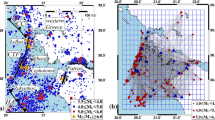Abstract
A broadband seismogram may be represented by a convolution of source time function, the propagation operator and the scattering/attenuation operator. As the propagation operator is frequency-independent, and the scattering/attenuation effect may be described by a Q-factor depending on frequency via Q −1=Q −11 +(Q 2 ω)−1, considering a combination of the displacement spectra, the source spectra may directly be estimated, in which the contribution of the Q-value may be eliminated automatically. Using this algorithm, the near-source broadband seismograms of five aftershocks of the 1988 Lancang-Gengma, Yunnan Province, China earthquake were processed. The results for the M L=3.0 and M L=3.5 aftershocks show that for the same earthquake, similar high-frequency fall-off may be obtained from different recording stations. The result for the M S=6.7 aftershock shows that consistent source parameters may be gotten from different seismic stations. The parameters estimated also agree with the results obtained by empirical Green’s function approach. The high-frequency spectra of the aftershocks exhibit a typical f −γ fall-off. For the M L=3.0 aftershock, γ≈3; for the M S=6.7 and M L=4.0 aftershocks, γ≈2; and for the M L=3.5 and M L=3.0 aftershocks, γ≈2.5. The corner frequency of the M S=6.7 aftershock indicates that it has a small source dimension, implying that it may come from the rupture of a small but strong barrier.
Similar content being viewed by others
References
Aki K. 1967. Scaling law of seismic spectrum. J Geophys Res, 72(4): 1 217–1 231
Atkinson G M. 1996. The high frequency shape of source spectrum for earthquakes in eastern and western Canada. Bull Seism Soc Amer, 86(1A): 106–112
Bath M. 1974. Spectral Analysis in Geophysics. Amsterdam: Elsevier Scientific, 563
Brune J N. 1970. Tectonic stress and the spectra of seismic shear waves from earthquakes. J Geophys Res, 75(26): 4 887–5 009
Chen Y T, Wu F T. 1989. Lancang-Gengma earthquake: A preliminary report on the November 6, 1988, event and its aftershocks. EOS, 70(49): 1 527–1 542
Claasen T A C M, Mecklenbraeuker W F G. 1980a. The Wigner- distribution: a tool for time-frequency signal analysis. I—Continuous-time signals. Philips J Res, 35: 217–250
Claasen T A C M, Mecklenbraeuker W F G. 1980b. The Wigner-distribution: a tool for time-frequency signal analysis. II—Descrete-time signals. Philips J Res, 35: 276–300
Claasen T A C M, Mecklenbraeuker W F G. 1980c. The Wigner-distribution a: tool for time-frequency signal analysis. III—Relations with other time-frequency signal analysis. Philips J Res, 35: 372–389
Frankel A. 1991. High-frequency spectral fall off of earthquakes, fractal dimension of complex rupture, b value, and the scaling of strength on the faults. J Geophys Res, 96(B4): 6 291–6 332
Hanks T C. 1979. b value and gw −γ seismic source models: implications for tectonic stress variations along active crustal fault zones and the estimation of high-frequency strong ground motion. J Geophys Res, 84(B5): 2 235–2 242
Hartzell S H. 1978. Earthquake aftershocks as Green’s Function. Geophys Res lett, 5(1): 1–4
Koyama J, Hara H. 1993. Rupture process of small-scale fault heterogeneities represented by scaled Langevin equation. In: Ding G Y, Chen Z L eds. Continental Earthquakes. Beijing: Seismological Press, 294–306
Toks ö ez M N, Dainty A M, Reiter E, et al. 1988. A model for attenuation and scattering in the Earth’s crust. Pure Appl Geophys, 128: 81–100
Wang P D, Chen Y T, Wang M. 1993. Near Source Strong Ground Motion Characteristics in Southwest China. Beijing: Seismological Press, 120 (in Chinese)
Wu F T, Wang P D, Chen Y T. 1987. Q P and Q S in Beijing and Jianchuan, Yunnan, China. Acta Seismologica Sinica, 1(4): 1–12
Wu Z L, Chen Y T, Ni J C, et al. 1994. Moment tensor inversion of near-source broadband data. Acta Seismologica Sinica, 7(2): 187–199 (in Chinese)
Wu Z L, Kim S G, Chen Y T. 1997. High-frequency fall-off of source spectra of deep-focus earthquakes from Wigner-distribution estimation. Phys Earth Planet Interior, 99: 221–229
Zheng Z Z, Hu J B. 1993. Instantaneous spectrum analysis and its application in estimation of earthquake tendency. Acta Seismologica Sinica, 6(2): 465–473
Author information
Authors and Affiliations
Additional information
Contribution No. 99FC2003, Institute of Geophysics, China Seismological Bureau, China.
This work is supported by the Joint Seismological Sciences Foundation (95-07-411). Also partly supported by NSFDYS49725410.
About this article
Cite this article
Mozaffari, P., Wu, ZL., Chen, YT. et al. High frequency fall-off of source spectra using Q-free spectra estimation. Acta Seimol. Sin. 12, 1–10 (1999). https://doi.org/10.1007/s11589-999-0001-x
Received:
Revised:
Accepted:
Issue Date:
DOI: https://doi.org/10.1007/s11589-999-0001-x




